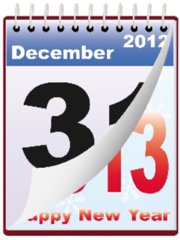Last week, I wrote about Beeminder, to help motivate you to keep your New Year's resolutions, and a few weeks ago, I reviewed the book "Your Best Just Got Better," which is a great book to read to figure out how to set meaningful goals.
This week I want to share some tools and methods to get past the "writer's block" that often stalls people when they sit down to write their goals and resolutions.
Getting your goals out of your head
It's pretty common for people to carve out a few cycles this time of year to make plans, new year's resolutions, and such. I'm a very visual person, so I find that using a mind map helps me organize my thoughts and stimulates my thinking. My tool of choice is MindManager from Mindjet, but you can find lots of other mind mapping alternatives on the other end of Google (FreeMind, for example, is free and Open Source).
I organized my map into three main "zones" (which you can see in the diagram below):
- A review of last year, where I identify highlights, lowlights, and missed opportunities
- A look ahead to help me frame my main areas of focus (more thematic or directional in nature)
- Making more concrete commitments I want to achieve (specific commitments and projects I want to focus on)
I've included my blank map below, and you can download my "New Year Reflection" mind map here. You can also launch an interactive (but not editable) version of the "New Year Reflection" mind map via this link (give it a bit of time - it has to download a Flash-based player).
Feel free to customize it so the prompts are more meaningful to you. And, if you use this approach, please let me know how it works out for you.
Still stuck? Try thinking about it another way...
If you'd rather think about your goals in terms of the roles and "categories" in your life, I have another template that may be useful, as well.
You can download my "2013 Success Planning" mind map here. And, if you don't have MindManager or a compatible alternative, the interactive (but not editable version of 2013 Success Planning can be accessed via this link (give it a bit of time - it has to download a Flash-based player). In this map, the "writing prompts" are in the Notes attached to each of the major categories - click on the little notepad icons and you'll see the prompts over in the notes pane on the right.








